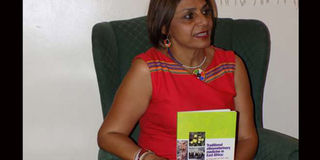My work is to make vet drugs from wild plants

Dr Najma Dharani, an ethnobotanist and a lecturer at Pwani University. Her work involves studying the relationship between animals and plants. PHOTO | THOMAS RAJULA | NATION MEDIA GROUP
What you need to know:
- Dr Dharani works with pastoral and agro-pastoral farmers. She visits herbalists and traditional practitioners in markets and homes and talks to community members and elders.
- In school, you need to study biology and environmental or natural resources–related subjects.
- To cure mastitis, use leaves and stems of ajuga remota herb.
Dr Najma Dharani is an ethnobotanist and a lecturer at Pwani University. Her work involves studying the relationship between animals and plants. She spoke with Carlos Mureithi on what ethnobotany is all about and why it matters to farmers.
What is ethnobotany?
It is all about plant-based cure for livestock and poultry diseases, basically. My work involves doing research on medicinal plants and their uses and administration and dosages for animals, poultry and human diseases.
I work with pastoral and agro-pastoral farmers, visit herbalists and traditional practitioners in markets and homes, and talk to community members and elders.
I share and they share knowledge. When in workshops and in the field seeing sick animals with certain symptoms of diseases, I advise them (the people) on which plant to use and how to prepare and how to administer medicine.
I have been doing this for 20 years.
What’s a typical day like for you when you’re out in the field?
Sometimes I randomly go to any farm. Farmers are very welcoming.
If they have any sick animal they tell me. So we all sit together and talk. It is so interesting. Disseminating knowledge is such an interesting job.
This is the most satisfying job that I’m doing, and I will continue even if I retire.
Tell us what plants you use to treat some animal diseases.
To cure mastitis, for instance, I use the leaves and stems of a very bitter herb called ajuga remota.
There are several other plants that can cure mastitis. To cure fowl typhoid, several ethno-medicinal plants can be used. You can use young leaves of croton megalocarpus.
What did you study?
I did my first degree, BSc (Hons) in botany, and second degree, MSc in botany, at the University of Karachi in Pakistan. I did a PhD in plant and ecology at the University of Nairobi.

Dr Najma Dharani, an ethnobotanist and a lecturer at Pwani University. PHOTO | THOMAS RAJULA | NATION MEDIA GROUP
What subjects do people who want to study ethnobotany need to have studied in secondary school?
In school you need to study biology and environmental or natural resources–related subjects that include agriculture.
At what levels of education can students study ethnobotany medicine?
At the diploma level when you study tourism and wildlife management, you also learn about medicinal plants. At the degree level and master’s level, people do projects and PhDs.
What jobs exist in this field?
You can become an ethnobotanist, pharmacologist or phytochemist. You can even become a professor. You can have your own pharmacy. You can work at the Kenya Medical Research Institute as a researcher. You can become a researcher even in universities, you can become a researcher in pharmaceutical industries, you can have your own pharmaceutical company or you can become a phytochemist. There is a lot of scope.
What do you love most about your job?
Sharing knowledge. I want to see farmers prosper. Their livelihoods should be enhanced.
You have a new book, Traditional ethno-veterinary medicine in East Africa: a manual on the use of medicinal plants. Tell us about it.
I worked in the entire East African region and did a lot of fieldwork. I talked to the herbalists there and communities. At the end, what we (co-authors and I) did was to give active ingredients for what plants they were using.
When you have active ingredients, then you know what the plant is used for.
***
Common names
Ajuga remota:
Mataliha (Luhya), chebonurar (Marakwet), karaci and Wanjiru wa rucii (Kikuyu)
Croton megalocarpus:
Mukinduri (Embu, Kikuyu, Kipsigis, Meru and Samburu), msenefu (Swahili), musine and omusala kwa tsibanda (Luhya), muthulu (Kamba), masineitet (Nandi), nyapo (Borana), nyaeppo (Duruma), nyaap’po (Gabra), muyama (Giriama), muthulu (Kamba), and mkigara (Taita)




